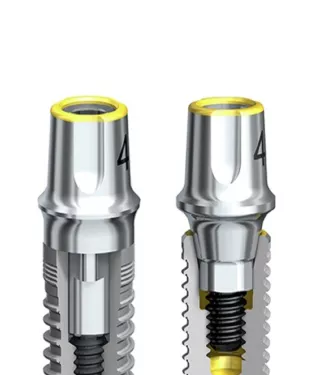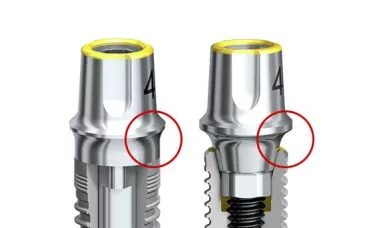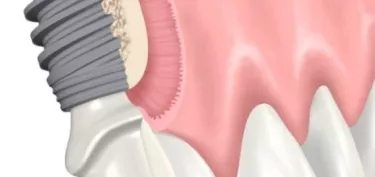
What is platform switching and how does it work?
Platform switching, also known as platform shifting, is whenever an abutment is used that is smaller in diameter than the implant platform.
How platform switching works
Numerous factors can affect both bone loss and soft tissue health around an implant. A significant study relating to platform switching was conducted by Lazzara et al, 2006.2 It describes how the concept was discovered accidentally over 25 years ago, when matching-diameter prosthetic components were not always commercially available and narrower ones were used instead. The study found, and hypothesized why, less crestal bone remodeling happens when smaller abutments are used on larger implant sites.
The theory is essentially based on biological width (the distance biologically needed between junctional epithelium and crestal bone which is about 2 mm) – deliberately creating through the platform switching a mesial component in the biological width so that marginal bone will stay at an upper level of the biological width. The advantages are discussed at length in the Lazzara text, and include also the idea that any inflammatory infiltrate is being moved away from the crestal bone.
Well-proven benefits of platform switching on dental implants
Many studies around the topic have supported the theory that platform switching is a way to improve the preservation of crestal bone for greater implant stability. Other benefits include improved esthetics, because preservation of crestal bone also benefits surrounding soft tissue. There is a wealth of recent work available that outline these positive benefits.3-5 One literature review found that “all papers show an improvement in peri-implant bone preservation and satisfactory esthetic results”.6
Embrace the philosophy: choosing the right component
When thinking about offering platform switching once you have built up your experience, it is important to choose the right component design.
Nobel Biocare has helped drive the concept of platform switching forward with NobelReplace, a tapered implant that mimics the shape of a natural tooth root. Clinicians have experienced excellent esthetics and good preservation in both soft tissue and crestal bone, with very good results at follow-up appointments.7 Alternatively, NobelParallel Conical Connection, also featuring platform switching, provides high primary stability and allows for universal use in all bone qualities and a wide range of indications.8-10 Nobel Biocare also provides high-quality training if this is an area where you would like to further develop your skills.
Platform switching is both proven and popular. If you are thinking about improving your skill set and developing your experience in dental implantology, find out more about platform switching and how it would work for you and your patients.

Make the switch
You've read about the biological and esthetic benefits of platform switching. Now, reach out to your local sales representative and take the next step in bringing platform switching to your practice.
Thinking about starting with dental implants?
Download our free educational e-book on how dental implants can help set your practice apart.
References
1. Prasad KD, Shetty M, Bansal N, Hegde C. Platform Switching: An answer to crestal bone loss. J Dent Implants. 2011;1:13-7. DOI: 10.4103/0974-6781.76426.
2. Lazzara RJ, Porter SS. Platform switching: a new concept in implant dentistry for controlling postrestorative crestal bone levels. International Journal of Periodontics & Restorative Dentistry. 2006 Jan 1; 26 (1).
3. Fickl S, Zuhr O, Stein JM, Hürzeler MB. Peri-implant bone level around implants with platform-switched abutments. The International Journal of Oral & Maxillofacial Implants. 2010 May 1;25 (3): 577.
4. Becker J, Ferrari D, Herten M, Kirsch A, Schaer A, Schwarz F. Influence of platform switching on crestal bone changes at non‐submerged titanium implants: a histomorphometrical study in dogs. Journal of Clinical Periodontology. 2007 Dec 1;34(12):1089-96.
5. Romanos GE, Javed F. Platform switching minimises crestal bone loss around dental implants: truth or myth? Journal of Oral Rehabilitation. 2014 Sep 1;41 (9):700-8.
6. Cumbo C, Marigo L, Somma F, La Torre G, Minciacchi I, D’addona A. Implant platform switching concept: a literature review. Eur Rev Med Pharmacol Sci. 2013 Feb 1; 17 (3): 392-7.
7. Lustbader D. Nobel Biocare. Media & News. Popular, well-proven concept. 2012 Jan. [Accessed Oct. 9, 2017]
8. Agliardi EL, Pozzi A, Stappert CF, Benzi R, Romeo D, Gherlone E (2014). Immediate Fixed Rehabilitation of the Edentulous Maxilla: A Prospective Clinical and Radiological Study after 3 Years of Loading. Clin Implant Dent Relat Res, 16(2), 292–302. doi: 10.1111/j.1708-8208.2012.00482.
9. Malo P, Araujo Nobre MD, Lopes A, Rodrigues R (epub ahead 2014). Double Full-Arch Versus Single FullArch, Four Implant-Supported Rehabilitations: A Retrospective, 5-Year Cohort Study. J Prosthodont. doi: 10.1111/jopr.12228.
10. Malo P, Nobre M. Flap vs. flapless surgical techniques at immediate implant function in predominantly soft bone for rehabilitation of partial edentulism: a prospective cohort study with follow-up of 1 year. Eur J Oral Implantol 2008;1(4):293-304.

